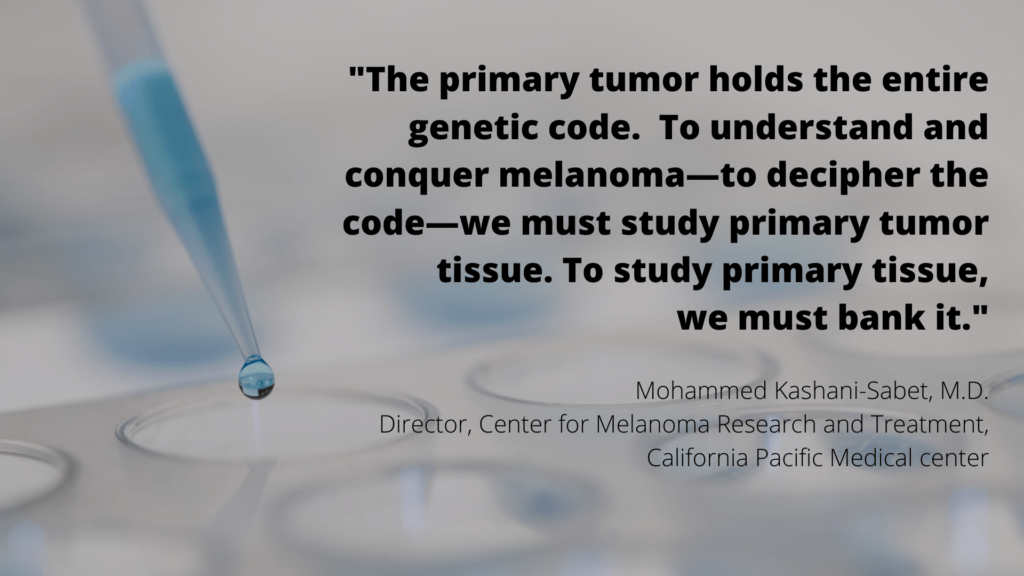The Time Is Now.
It’s one of the fastest-growing cancers in the United States and worldwide. It’s one of the most complex forms of cancer. It has the most mutations of all solid cancers. It’s the second most common cancer in those 15-29 years old.
Thousands are dying each year.
AIM at Melanoma intends to change that. AIM is boldly doing something that no other research institution, foundation, or medical center has done for melanoma.
AIM has brought together six esteemed institutions and researchers to establish the first collaborative melanoma tissue bank consortium.
Together, we are collecting more than 500 fresh-frozen primary melanoma tissue samples and corresponding patient data—and then performing much-needed research with those samples to answer some of melanoma’s most critical questions:
- Who will develop melanoma, and why?
- Whose melanomas will spread and become deadly?
- Which drugs will work on which patients?
Ultimately, the International Melanoma Tissue Bank Consortium (IMTBC) will help us make significant progress toward finding the cure.
A Global First
A fresh-frozen primary tissue bank—fully annotated and collaborative—has never been achieved before in melanoma, and it has taken more than a decade of dedicated work to accomplish. The IMTBC is a global first because of the following combination of factors:
- It’s a consortium—the six institutions are sharing data and tissue samples with each other
- It’s collaborative—researchers around the world can apply to obtain tissue samples and data for research
- The tissue will be fresh frozen—RNA is preserved, unlike in the standard formalin-fixed, paraffin-embedded process
- The tumors are primary—not metastasized
- There will be a critical mass—a goal of 500 in the first two years, and continued collection thereafter
- Full annotation will accompany each tissue—patient data, including full medical history (personalized), will be available for study along with the tissue
- Samples will accompany each tissue—blood and urine samples will be collected for each patient
Welcome Skin of Steel Supporters
In 2010, Valerie Guild and Susan Steel were introduced. They were two determined women who had founded non-profits to advance the battle against melanoma and accelerate the quest for the cure. Val’s drive came from her daughter Charlie’s death from melanoma at 26 years old. Susan’s came from her own battle with melanoma—one she lost in 2016.
Susan named her foundation Skin of Steel (SOS) and initially focused on sun safety education and bringing clinical trials in melanoma to the greater Chicago area. But after meeting Val, she decided to devote SOS’s fundraising efforts to AIM’s principal research initiative, the International Melanoma Tissue Bank Consortium—IMTBC for short. IMTBC is collecting 500 fresh frozen primary melanoma tumors and the corresponding anonymized patient data for each into a shared repository for collaborative research among six institutions as well as for other researchers around the world who apply to use the tissue. The four U.S. sites are open and collecting tissue now, and the two in Australia will open soon.
Other research institutions have tissue banks for melanoma, mostly with metastasized tumors. But no bank is so widely collaborative AND has a critical mass of fresh frozen primary tumors AND depersonalized data.
Both Val and Susan have passed away, but their work lives on. AIM at Melanoma is led by Valerie’s daughter Samantha, and funding IMTBC is our most critical goal. SOS closed their doors in early 2023, but their last president, Steve Sullivan, has joined the board of IMTBC. We welcome SOS supporters to the AIM family!
How much does the tissue bank cost?
The cost to create and operate all six branches for the next three years is $3.1M. To date, we’ve raised more than $1.5M.
Is the tissue bank an actual building?
No, the tissue bank operates within existing medical centers. All physicians, ancillary personnel, and equipment needed to run the branches will be funded by AIM at Melanoma Research Foundation.
Where are the locations?
- Hillman CancerCenter,
University of Pittsburgh Medical Center (UPMC) - Knight Cancer Institute,
Oregon Health and Science University (OHSU) - California Pacific Medical Center (CPMC)
- Robert H. Lurie Comprehensive Cancer Center,
Northwestern University - Peter MacCallum Cancer Centre, Victoria, Australia
- Alfred Hospital, Melbourne, Victoria, Australia
Can other researchers use the tissue?
Yes, researchers from institutions anywhere in the world may apply to study the tissue. The Consortium will grant the use of available tissue to promising research projects.

Why Is The Tissue So Important?
What Will Researchers Do That They Can’t Do Now?
Approved research projects include using the tissue to:
 Identify the difference in gene signatures between benign moles and primary melanoma.
Identify the difference in gene signatures between benign moles and primary melanoma.
IMAGINE: We’re able to develop a diagnostic test—to know quickly and easily which moles and skin lesions are potentially deadly and which are benign.
 Compare the gene signatures of a patient’s primary tumor vs. lymph node or distant metastatic melanoma tumors, to determine the molecular factors involved in progression of the tumor in the patient.
Compare the gene signatures of a patient’s primary tumor vs. lymph node or distant metastatic melanoma tumors, to determine the molecular factors involved in progression of the tumor in the patient.
IMAGINE: We’re able to accurately tell which patients’ melanomas will spread—and where; which will become deadly; and which will not.
 Evaluate the role that the primary tumor has on impacting the immune system, the lymph nodes, and distant sites where the tumor may spread.
Evaluate the role that the primary tumor has on impacting the immune system, the lymph nodes, and distant sites where the tumor may spread.
IMAGINE: We’re able to discover new approaches to reinvigorating the anti-tumor function of immune cells—and let our immune systems fight off the cancer.
 Understand how the metabolism in the original tumor impacts the aggressiveness of the tumor and its response to immunotherapy.
Understand how the metabolism in the original tumor impacts the aggressiveness of the tumor and its response to immunotherapy.
IMAGINE: We’re able to understand which melanomas will respond to immunotherapy and why, so we can develop treatments that work for all patients.
Help Us Find The Cure
We know from other cancers that significant discoveries will emerge from collaborative research on fresh-frozen primary tissue samples and corresponding patient data.
We know from other cancers that fresh-frozen tissue, retaining both high-quality DNA and RNA, will contain the genetic biomarkers critical to advancing personalized medicine.
We know from other cancers that a tissue bank is an essential step on the road to conquering melanoma.
We know the time is now.
